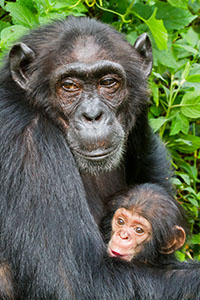Early Experiences Shape Aggression in Young Chimpanzees
Departmental News
Posted: Mar 23, 2021 - 12:00pm

Dr. Kris Sabbi, who recently completed her PhD in Anthropology at The University of New Mexico under professors Melissa Emery Thompson and Martin Muller, did her dissertation research about the developmental origins of sex differences in chimpanzee social behavior. She is now a postdoctoral researcher at Tufts University (co-appointed in anthropology and biology), retains a position as an adjunct assistant professor in the UNM Anthropology department, and continues to work in the CHmPP Center in PAIS. Her new publication is called Sex differences in early experience and the development of aggression in wild chimpanzees.
“One of my goals as an anthropologist and a primatologist is to learn about human behavioral evolution by studying the behavior and ecology of living primates. As adults, male and female chimpanzees have very different social strategies, including differences in how frequently and for what purposes they use physical aggression with males generally using more intense forms of physical aggression and using them more often than females. These are differences that we also observe across human cultures- where men tend to use more violence than women from the same culture,” Sabbi said.
One explanation for this sex difference in humans is that human children and babies are treated differently based on their gender. “We call this gender socialization and it’s one of the reasons that people refer to gender as a social construct. Even though violence is generally discouraged overall, physical aggression and physical expressions of anger are more acceptable behavior from boys compared to girls, and some think that this is how boys grow up to be more physically aggressive as men.” Sabbi explained.
“However, since we observe very similar sex-biased patterns in physical aggression in other species, especially in species like chimpanzees, who are so closely related to us, there is probably some shared evolutionary history and shared developmental processes- in addition to human-like gender socialization- that shape these patterns, too.” Read more
